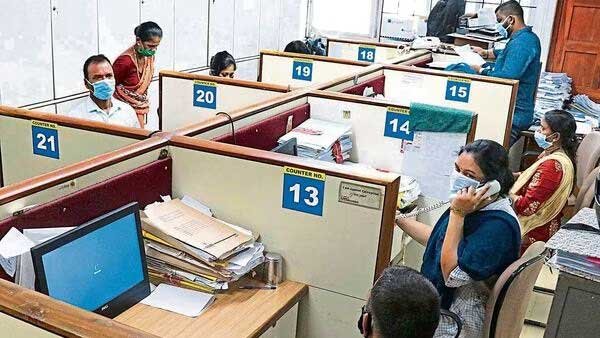As India grapples with a new surge in COVID-19 cases, companies are rigorously reinforcing health protocols without necessarily returning to remote work. This article explores how India Inc is balancing the health of employees with the need to sustain business operations amid pandemic challenges.
Adaptation to COVID-19 Surge: India Inc’s Stance
Corporate Vigilance Amid Rising Cases
Despite a concerning uptick in COVID-19 cases, India’s corporate sector remains undeterred. Businesses are adopting certain safeguards but are shying away from reinstating full Work From Home (WFH) protocols. Recruiters echo this sentiment, foreseeing no immediate downturn in hiring activities due to the resurgence.
Proactive Measures for Employee Safety
Firms have revitalized their internal COVID-19 response teams, urging them to keep a vigilant eye on employee health. The emphasis is on conventional safety measures: mask usage and rigorous sanitation practices.
Santanu Banerjee of Bajaj Allianz Life Insurance highlights, “We’ve reactivated our internal reporting system around three weeks ago.” This system mandates team leaders to update the Human Resources department on the status of affected employees without a shift back to a WFH model.
Response to JN.1 Variant Concerns
With a new variant named JN.1 emerging, companies are intensifying their safety measures. The latest health ministry data reports a jump to 4,093 active COVID-19 cases, amplifying concerns.
“At Panasonic Life Solutions India, we are amplifying our safety directives,” CHRO Adarsh Mishra says. Panasonic advises strict adherence to COVID-19 precautions, stressing immediate medical attention for any symptoms linked to the JN.1 variant.
Emphasizing Health and Safety
Vedanta Group’s approach is defined by their commitment to health and safety. Deputy CHRO Praveen Purohit remarks, “As the number of cases climbs, we reinforce health guidance and engage with our team through town halls.” The corporation stands by the essential preventive steps: compulsory masking and sanitization. By maintaining a steady course and fostering rigorous safety protocols, India Inc is navigating through the pandemic’s latest challenges while keeping its workforce active and recruitment steady.
The Evolution of Work Arrangements
As we navigated through the daunting pandemic phase, businesses widely adopted the Work From Home (WFH) model. Recently though, there’s been a pivotal shift with companies increasingly urging employees to return to the office. Despite this push, corporate giants maintain a stance on preserving hybrid work policies.
“Even with the gradual increase in office attendance, our hybrid model remains intact. With a schedule of 2-3 days a week in the office, we are staying the course,” says S. Venkatesh, the Group President of HR at RPG Enterprises. He adds, “Anyone displaying symptoms will be required to work from home.”
Hiring and the Hybrid Model
The recruiter outlook reveals a positive trend, anticipating stability in the job market. Teamlease Services, a staffing firm, echoes this sentiment. Kartik Narayan, their CEO of Staffing, states, “We are not predicting a hiring freeze. In fact, we’re preparing for a hiring surge over the next few months.”
The IT Sector’s Struggle
The shift back to office life is most challenging for the IT industry, which not only faces returning employees but also grapples with high turnover rates. The pandemic’s remote work wave led to a decrease in urban housing demand as tech professionals moved out. Now, managers are mandated to bring most of their workforce back to the office for three days a week.
Wipro has officially stated, “Since November, fully vaccinated staff have been coming in three times a week. We are committed to complying with local health regulations and ensuring all precautionary measures are enforced.”
Ready for a Virtual Switch if Needed
“Most firms have grown adept at executing WFH strategies when necessary,” comments Narayan from Teamlease. He adds that this preparedness is viable as long as the public health scenario does not devolve to a level that hampers consumer demand.
In summary, the message is clear: while the transition towards in-person work is evident, flexibility remains a top priority for businesses and the adaptability to remote work is now a staple in organizational strategy.











